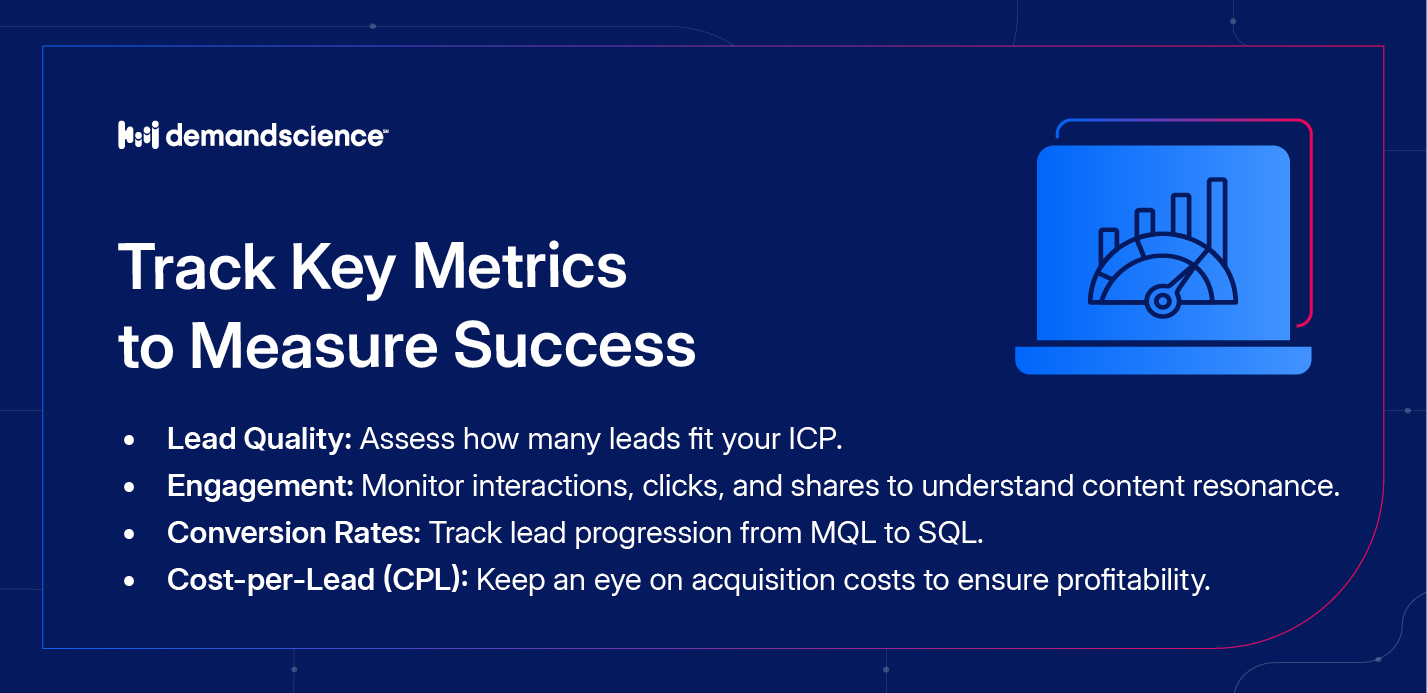
Does content syndication work? It does. But without metrics to serve as your milestones, you will never know how far your campaigns have reached. You need to have a comprehensive understanding of how your content is performing, where your audience is engaging, and which channels are driving the most valuable results.
The purpose of content syndication is simple: it takes your top-performing content, expands its reach to larger audiences, and kicks your lead generation into high gear. But when you get closer to the task at hand, you start to realize the success of a content syndication campaign is more than just the leads it generates; it’s also about the engagement it drives and the valuable web traffic it brings in.
So, let’s take a closer look at some of these important performance metrics, get a good understanding of what they’re all about, and learn how you can use them to optimize future content syndication efforts.
Why tracking content syndication performance is important
Measuring content syndication results isn’t just about calculating ROI; ultimately, it’s about maximizing it. By leveraging the insights you gather from any one campaign, you can continuously improve upon each previous effort to boost ROI even higher.
Monitoring performance helps you maximize content syndication ROI by helping you scale what’s working and minimize what’s not.
For example, when you look at how leads engage with your content across multiple channels, you can begin to identify types of content that effectively generate the most engagement, drive the most quality leads, and convert more customers over a given time. Likewise, you can also gauge which content types tend to move the needle with target audiences, or which platforms garner the most use among ideal buyers.
This knowledge helps you tweak your existing content strategy so you can get an even bigger return on your next content syndication venture.
Here are a few strategic elements you can refine using the learnings you’ve gathered from content syndication performance metrics:
- Pinpointing more relevant content
- Refining your ICP for better targeting
- Improving budget planning
- Prioritizing channels
- Optimizing nurture campaigns
- Improving click-through traffic to the website
- Setting more realistic benchmarks for future performance
Content syndication metrics you should be tracking
Measuring the performance of your content syndication initiatives allows you to make data-driven decisions, optimize your strategies, and ensure that your content is reaching the right audience and driving the desired outcomes. However, it’s important to note that choosing the right metrics to track your content syndication performance depends on two things: the goals you set for the campaign itself and the types of content you plan to distribute.
If the goal of your content syndication campaign is to expand brand awareness, it’s best to share more top-funnel content that’s light, speaks to a wider audience, and shows thoughtful industry insight. You’ll base your specific KPIs (key performance indicators) on that, and focus, for example, on impressions and CTR (click-through rate) across channels like YouTube and LinkedIn. In other words, you want to make sure the data you track can help you achieve the goal you’ve set.
Now, here are more important metrics you should use to track and improve content syndication performance, especially when it comes to B2B lead generation:
- Lead volume, quality, and engagement
- Content engagement
- Content reach
- User behavior
- Costs
Lead volume, quality, and engagement
In most cases, lead generation is the main objective of content syndication. But to really determine the effectiveness of your syndication efforts, you have to concentrate on the quality of those leads. The more qualified a lead is, the better chances you have of driving valuable marketing revenue. Once you know which pieces of content successfully drive quality leads—and who among those leads become customers over time—you can plan your next syndication campaign accordingly.
To do that, dig into these metrics, either per campaign or cumulatively over time:
- Lead volume – The total number of leads generated through your content syndication campaign
- Lead quality – Percentage of leads who qualify as marketing-qualified leads (MQLs) or sales-qualified leads (SQLs)
- Conversion rate – Percentage of leads who convert into customers over time
- Sales cycle length – The average amount of time it takes for a lead to progress from initial engagement to closed sale
When you analyze these syndication metrics, you can take steps to improve your performance and produce high-intent MQLs.
Content engagement metrics
Engagement metrics can help you determine what content topics or formats resonate most with your target audience. And this is key because engagement is a huge indicator of purchase intent. When you see that a prospect has clicked on an ad, downloaded an eBook, or shared a social media post, it’s a clear sign that the prospect is interested in what your content has to offer. From that point, it’s easy to identify who, among all prospects, has the most potential to become an MQL.
Not only that, but you can get a pretty good idea of where these prospects are in their respective customer journeys based on the kind of content they engage with. For instance, if someone fills out a form to read a white paper, it’s a sign that the person is probably in the mid-stages of their sales journey and looking for more specific info on your business. It’s also a sign you’ve got an in-market lead on your hands. And since you already know that person’s interests based on the content they’ve engaged with, your sales team can tailor outreach.
These are the metrics that prove most helpful when you’re trying to understand how your audience engages with your content:
- Asset downloads – Number of times a specific piece of content is downloaded
- Form fills – Number of times prospects complete a contact form to access a gated asset
- Webinar registrations – Number of prospects who have signed up to attend a webinar
- Webinar attendance – Number of people who attend a webinar
- Video view completion rates – Average time prospects spend watching video content
- Social media shares – Number of times users share your content across various social media platforms
- Email forwards – Number of times email recipients forward your content (tip: use the “forward to a friend” option in your email service provider for more accurate reporting)
- Amplification rate – The number of shares divided by total number of followers, multiplied by 100 to get a percentage (This metric helps you understand relative share rates over time or across different platforms with varying audience sizes.)
Content reach metrics
At the end of the day, lead generation is all a numbers game, so to drill down on only the most qualified of the bunch, you need to cast a wide net with your content syndication efforts.
To do that, it’s important to track these metrics, which can help you identify the most optimal syndication channels and audience segments to support your content syndication goals.
- Total impressions – Number of times your content is displayed on screen
- Web traffic – Measurement of unique and repeat website visitors
- Newsletter subscribers – Number of prospects who have signed up to receive a newsletter
- Podcast listeners – Number of prospects who tune into a podcast
- Social network followers – Number of followers across your social media channels
- Publication readership – Average number of readers per asset
User behavior metrics
As we’ve mentioned, engagement is a hugely important metric in tracking content syndication success. But it’s equally important to track how well that content can effectively keep prospects engaged. If you find there’s been a drop in page views or a bump in bounce rates, you might need to tune up your content syndication strategy.
By reviewing user behavior metrics, you can see whether your landing pages need more relevant keywords, whether you need to include more suitable offers for prospects, or whether your site needs a redesign to provide a better user experience.
When you want to take a peek at how well your content encourages action and engagement among prospective customers, look no further than these metrics:
- Bounce rates – Percentage of visitors who leave your website after viewing only one page
- Page views – Total number of users on your website or landing page
- Average time on page – Average amount of time users spend on a specific web page or piece of content
- Pages per session – Average number of pages viewed by users during a single visit to your website
- Scroll depth – Average length visitors scroll down a page to read more
On the flip side, if metrics reveal your prospects have spent a significant amount of time on your page, they’ve scrolled to the bottom for continued reading, and they’ve clicked through to additional content, pat yourself on the back—you’ve just executed an effective content strategy.
Financial metrics
Ultimately, content syndication performance boils down to dollars and cents, so you’ll want to focus on these two key financial metrics to measure the impact of your syndicated content:
- Cost-per-lead (CPL) – How much you spend to acquire one lead
It’s important to note that this metric is typically reserved for those working with a paid content syndication vendor. Together, you and your content syndication partner can determine a guaranteed CPL based on your target audience criteria and existing budget. This way, you’ll know exactly how much it’ll cost to get the results you want. And since paid vendors take a more data-driven approach to content syndication, resulting in faster, more successful lead generation, you’ll probably get the most bang for your buck.
To find your CPL sweet spot, take your total content syndication spend and divide that by the average number of leads you’ve generated from your last few campaigns. That number will help determine a more appropriate CPL price point for your content syndication vendor.
Whether you take the DIY approach or work with a content syndication vendor, it’s imperative you measure your ROI. Otherwise, how will you know if your hard work was worth all the investment?

By analyzing any of the metrics we’ve mentioned here, including generated leads, CPL, and conversions (among many others), and comparing those to the total cost of your efforts, including time spent creating content or working with a paid vendor, you can get a clear picture of content syndication’s overall value. And if metrics show an impressive ROI, you have a solid case for increasing your team’s content syndication budget.
Analyzing Conversions and Interpreting Analyzing Content Syndication Data
Ultimately, the success of your content syndication efforts should be measured by their ability to drive conversions and generate high-quality leads for your business. By tracking the conversion rates, lead generation, and other sales-related metrics associated with your syndicated content, you can determine the true impact of your content syndication strategy on your business objectives.
Collecting and analyzing the various content syndication metrics is only the first step. To truly leverage the insights from your data, you need to interpret the information and use it to inform your content marketing strategies.
Look for patterns and trends in your data, identify the top-performing content and channels, and understand the underlying factors that contribute to the success or failure of your syndicated content. Use these insights to refine your content creation, syndication, and promotional efforts, and continuously optimize your strategies to achieve better results.
Content syndication is a measurable way to do your targeted content promotions. It is a powerful tool for businesses to amplify their reach, drive more traffic, and generate valuable leads. By tracking the right metrics, you can measure the effectiveness of your content syndication campaigns and make data-driven decisions to optimize your strategies.
How DemandScience’s Content Syndication Solution Stands Out from the Rest of the Pack
Our content syndication solution is designed to help businesses like yours maximize the impact of their content marketing efforts and achieve measurable results.
Unlike other content syndication providers, DemandScience offers a comprehensive suite of features and capabilities that set us apart from the competition. Our platform leverages advanced data-driven targeting and real-time performance tracking to deliver exceptional results for our clients.
With DemandScience, you can:
- Reach a Targeted Audience: Our advanced targeting capabilities allow you to reach the right audience for your content, ensuring that your message resonates with the people who matter most to your business.
- Track and Measure Success: Our comprehensive reporting and analytics dashboard provides you with real-time insights into the performance of your content syndication campaigns, enabling you to make data-driven decisions and continuously improve your strategies.
- Seamless Integration: DemandScience seamlessly integrates with your existing marketing stack, allowing you to streamline your content syndication efforts and maximize the value of your existing investments.
- Dedicated Support: Our team of content syndication experts is here to support you every step of the way, providing strategic guidance, best practices, and hands-on assistance to ensure the success of your content marketing initiatives.
By choosing DemandScience as your content syndication partner, you can unlock the full potential of your content marketing efforts and drive measurable results for your business.
Haven’t geared up on your syndication efforts yet? Let’s change that.











